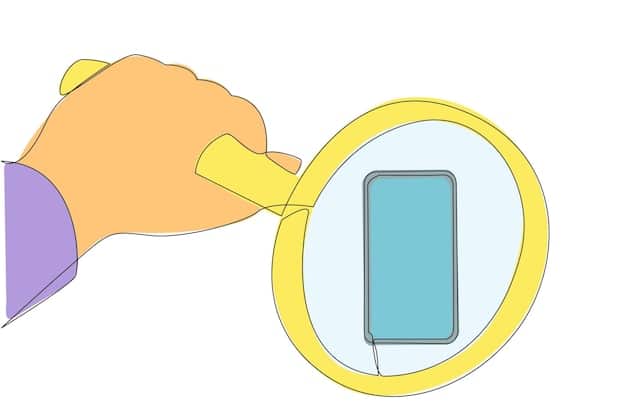How to Spot Fake Online Reviews in 2025: A US Shopper’s Guide

Identifying fake online reviews in 2025 requires a keen eye for detail, including analyzing language patterns, verifying reviewer authenticity, and using tools to detect suspicious activity, ensuring US shoppers make informed purchasing decisions.
Navigating the world of online shopping can be tricky, especially when it comes to trusting online reviews. This guide, **How to Identify Fake Online Reviews in 2025: A US Shopper’s Guide**, will equip you with the knowledge and tools to spot potentially misleading feedback, ensuring you make informed purchasing decisions.
Why Fake Reviews Matter to US Shoppers
Fake reviews can significantly impact purchasing decisions in the US. By artificially inflating or deflating product ratings, these deceptive reviews mislead consumers, leading them to buy subpar products or avoid potentially great ones. Understanding the impact is the first step in protecting yourself.
The Economic Impact of Fake Reviews
The prevalence of fake reviews has substantial economic consequences. US consumers lose billions of dollars annually due to purchases influenced by fake reviews. This erodes trust in online marketplaces and legitimate businesses that rely on genuine feedback.
Erosion of Trust in Online Marketplaces
When consumers encounter fake reviews, they lose faith in the integrity of online marketplaces. This skepticism can lead to reduced online shopping activity, impacting the overall e-commerce ecosystem. Transparency and authenticity are crucial for maintaining consumer trust.
- Financial Losses: Fake reviews directly lead to consumers wasting money on misrepresented products.
- Damaged Reputations: Genuine businesses suffer when fake negative reviews are used to sabotage their products.
- Market Distortion: The presence of fake reviews skews market signals, making it difficult for consumers to identify truly valuable products.
Identifying and avoiding fake reviews is not just about saving money; it’s about preserving the reliability and trustworthiness of online shopping environments.
The Evolving Tactics of Fake Reviewers in 2025
Fake review tactics are becoming increasingly sophisticated. In 2025, expect to see more realistic-sounding reviews generated by advanced AI, making it harder to distinguish between genuine and fraudulent feedback. Staying informed about these evolving methods is crucial for US shoppers.
AI-Generated Reviews: The New Frontier
Artificial intelligence is now being used to create highly convincing fake reviews. These AI-generated reviews can mimic human writing styles, making them difficult to detect through traditional methods.
Coordinated Review Campaigns
Organized groups are becoming more prevalent in orchestrating fake review campaigns. These groups often target specific products or businesses, either to promote them artificially or to damage their reputation.

- Sentiment Analysis Evasion: Fake reviewers are becoming better at bypassing sentiment analysis tools.
- Realistic Language: AI-generated reviews now include more natural-sounding language and varied sentence structures.
- Emotional Manipulation: Reviews are crafted to evoke specific emotions, influencing purchasing decisions more effectively.
The key to staying ahead is to adopt more nuanced detection methods and to leverage tools that can analyze patterns beyond just the text of the review.
Red Flags: Spotting the Obvious Fake Reviews
Despite the increasing sophistication, many fake reviews still exhibit telltale signs. Recognizing these red flags can help US shoppers quickly identify potentially fraudulent feedback. Look for patterns and inconsistencies that stand out.
Generic Praise or Criticism
Fake reviews often use overly generic language, lacking specific details about the product or service. They might simply say “Great product!” or “Terrible experience!” without explaining why.
Suspicious Language Patterns
Be wary of reviews that use unusual grammar, awkward phrasing, or repetitive language. These can be indicators of non-native English speakers or AI-generated content.
Look for an excessive use of superlatives, such as “the best,” “the most amazing,” or “the worst.” Genuine reviews tend to be more balanced and nuanced.

- Vague Descriptions: Lack of specific details about the product’s features or performance.
- Repetitive Keywords: Overuse of keywords to manipulate search rankings.
- Unrealistic Positivity or Negativity: Extreme opinions without supporting evidence.
Combining these observations with other detection methods will increase your ability to spot fake reviews effectively.
Advanced Techniques for Detecting Sophisticated Fakes
To combat the more sophisticated fake reviews of 2025, US shoppers need to employ advanced detection techniques. This includes analyzing reviewer profiles, using specialized tools, and understanding how to interpret complex data.
Analyzing Reviewer Profiles
Examine the reviewer’s profile for suspicious activity. Look for patterns like a large number of reviews posted in a short period, or reviews that are all highly positive or negative.
Leveraging Specialized Tools and Extensions
Several tools and browser extensions can help detect fake reviews. These tools analyze various factors, such as the reviewer’s history, language patterns, and review content, to provide a credibility score.
Pay attention to the reviewer’s network. Are they connected to other reviewers who also post suspicious feedback? Do they have a consistent history of reviewing similar types of products?
- ReviewMeta: Analyzes Amazon reviews and identifies potentially unreliable feedback.
- Fakespot: Detects fake reviews on various platforms using AI algorithms.
- TheReviewIndex: Aggregates reviews from multiple sources to provide a more comprehensive overview.
By using these tools and techniques, you can go beyond surface-level analysis and uncover more deeply hidden fake reviews.
The Role of AI and Machine Learning in Combating Fake Reviews
Artificial intelligence and machine learning are playing an increasingly important role in the fight against fake reviews. These technologies can analyze vast amounts of data to identify patterns and anomalies that are invisible to the human eye. Understanding their capabilities can help US shoppers make more informed decisions.
How AI Identifies Suspicious Patterns
AI algorithms can identify patterns in language, behavior, and network connections that indicate fraudulent activity. This includes detecting coordinated review campaigns and identifying AI-generated content.
Predictive Analysis and Trend Spotting
Machine learning models can predict which reviews are likely to be fake based on historical data. They can also spot emerging trends in fake review tactics, allowing platforms to adapt their detection methods proactively.
Platforms are using AI to continuously monitor review activity, flagging suspicious accounts and removing fraudulent feedback in real-time.
- Natural Language Processing (NLP): Analyzes the sentiment and language used in reviews.
- Anomaly Detection: Identifies unusual patterns in reviewer behavior.
- Network Analysis: Examines the connections between reviewers to detect coordinated campaigns.
By embracing AI and machine learning, online marketplaces can create a more trustworthy and reliable shopping environment for US consumers.
Staying Ahead: Tips for US Shoppers in 2025
The battle against fake reviews is ongoing, but US shoppers can take proactive steps to protect themselves. By staying informed, using the right tools, and exercising caution, you can minimize the risk of being deceived.
Verify Information Across Multiple Sources
Don’t rely solely on reviews from a single platform. Check multiple sources to get a more balanced perspective.
Trust Your Gut Instinct
If something seems too good to be true, it probably is. Trust your intuition and exercise caution when encountering overly positive or negative reviews.
Stay informed about the latest fake review tactics and detection methods.
- Read Widely: Consult various review sources, including independent blogs and consumer reports.
- Cross-Reference: Compare reviews across different platforms to identify consistent feedback patterns.
- Be Skeptical: Approach online reviews with a healthy dose of skepticism and critical thinking.
By following these tips, US shoppers can navigate the online marketplace with greater confidence and avoid being misled by fake reviews.
| Key Point | Brief Description |
|---|---|
| 🔍 Analyze Language | Look for generic praise, odd phrasing, and excessive superlatives. |
| 🕵️ Reviewer Profiles | Check for review bombing, unusually high or low review counts. |
| 🤖 AI Detection Tools | Use tools like Fakespot to assess review credibility. |
| 🌐 Cross-Reference | Verify information across multiple sources for a balanced view. |
FAQ
▼
Generic praise, repetitive language, and a lack of specific details about the product are key indicators. Also, check the reviewer’s profile for suspicious activity, such as a high volume of reviews in a short period.
▼
AI can analyze language patterns, reviewer behavior, and network connections to identify fraudulent reviews. It can also detect AI-generated content and coordinated review campaigns more effectively than humans.
▼
Yes, tools like ReviewMeta and Fakespot analyze reviews and provide credibility scores based on various factors. Browser extensions like TheReviewIndex also aggregate reviews from multiple sources for a comprehensive overview.
▼
Report the review to the platform where it was posted. Also, cross-reference the information with other sources and trust your gut instinct – if something seems too good to be true, it probably is.
▼
Fake reviews are becoming more sophisticated, with AI-generated content and coordinated campaigns on the rise. This makes it harder to distinguish between genuine and fraudulent feedback, requiring more advanced detection techniques.
Conclusion
As online shopping continues to evolve, the tactics used by fake reviewers will only become more sophisticated. By staying informed about these evolving methods, utilizing advanced detection techniques, and exercising caution, US shoppers can protect themselves from being misled and make more informed purchasing decisions in 2025.





